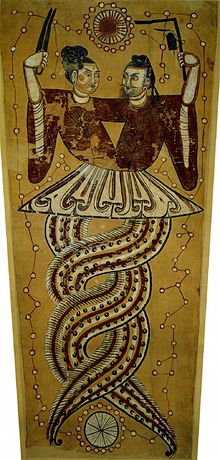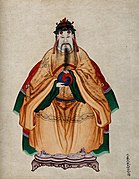Фуси
| Фуси | |||
|---|---|---|---|
 Fuxi and Nüwa. Hanging scroll. Color on silk. Located at the Chinese History Museum. | |||
| Chinese | 伏羲 | ||
| |||
| Part of a series on |
| Chinese folk religion |
|---|
 |
Фуси или Фу Си (Фуси) [ а ] [ 1 ] — культурный герой китайской мифологии , которому вместе со своей сестрой и женой Нюва приписывают создание человечества и изобретение музыки. [ 2 ] охота, рыбалка, одомашнивание, [ 3 ] и кулинария, а также Цанцзе система письма китайских иероглифов около 2900 г. до н.э. [ 4 ] или 2000 г. до н.э. Фуси считался первым мифическим императором Китая, « божественным существом с телом змеи», чудесным образом рожденным. [ 5 ] даосское Трех божество и/или член Правителей в начале китайского династического периода .
Некоторые изображения изображают его как человека со змееподобными характеристиками, «голову, покрытую листьями, растущую из горы», «или как человека, одетого в шкуры животных». [ 5 ]
Имена
[ редактировать ]Он также известен как Бао Си (包牺) и Ми Си (宓羲). [ 5 ]
Origin
[edit]Pangu was said to be the creation god in Chinese mythology. He was a giant sleeping within an egg of chaos. As he awoke, he stood up and divided the sky and the earth. Pangu then died after standing up, and his body turned into rivers, mountains, plants, animals, and everything else in the world, among which is a powerful being known as Huaxu (華胥). Huaxu gave birth to a twin brother and sister, Fuxi and Nüwa. Fuxi and Nüwa are said to be creatures that have faces of human and bodies of snakes.[6]
However, in some myths, Fuxi was held to be the creator, not Pangu, who worked alone and not with Nüwa.[7]
Fuxi was known as the "original god", and he was said to have been born in the lower-middle reaches of the Yellow River in a place called Chengji (成紀) (possibly modern Lantian, Shaanxi province, or Tianshui, Gansu province).[8]
A possible historical interpretation of the myth is that Huaxu (Fuxi's mother) was a leader during the matriarchal society (c. 2600 BC) as early Chinese developed language skill while Fuxi and Nüwa were leaders in the early patriarchal society (c. 2600 BC) while Chinese began the marriage rituals.[9]
A divinity Taihao (太皞, "The Great Bright One") appears, vaguely, in sources before the Han dynasty, independent from Fuxi. Later, Fuxi is identified with Taihao, the latter being his courtesy or formal[5] name.[10]
According to legend, the goddess of the Luo River, Mifei, was the daughter of Fuxi. Additionally, some versions of the legend state that she is Fuxi's consort. She drowned in the Luo River while crossing it and became the spirit of the Luo River.[11]
Creation legend
[edit]According to the Classic of Mountains and Seas, Fuxi and Nüwa were the original humans who lived on the mythological Kunlun Mountain (today's Huashan). One day they set up two separated piles of fire, and the fire eventually became one. Under the fire, they decided to become husband and wife. Fuxi and Nüwa used clay to create offspring, and with the divine power they made the clay figures come alive.[8] These clay figures were the earliest human beings. Fuxi and Nüwa were usually recognized by Chinese as two of the Three Sovereigns in the early patriarchal society in China (c. 2600 BC), based on the myth about Fuxi establishing marriage ritual in his tribe. The creation of human beings was a symbolic story of having a larger family structure that included the figure of a father.
Social importance
[edit]On one of the columns of the Fuxi Temple in Gansu Province, the following couplet describes Fuxi's importance: "Among the three primogenitors of Huaxia civilization, Fu Xi in Huaiyang Country ranks first."[8] During the time of his predecessor Nüwa, society was matriarchal.
古之時未有三綱、六紀,民人但知其母,不知其父,能覆前而不能覆後,臥之言去言去,起之吁吁,饑即求食,飽即棄余,茹毛飲血而衣皮葦。於是伏羲仰觀象於天,俯察法於地,因夫婦正五行,始定人道,畫八卦以治下。
In the beginning there was as yet no moral (Sangang) or social order. Men knew their mothers only, not their fathers.
[Missing translation of the following three sentences: 能覆前而不能覆後 They could only know/trace their offsprings but not their progenitors (promiscuous without family concept), 臥之言去言去 They slept whenever they wanted (non-circadian without concept of time), 起之吁吁 When awoke, they started yue-ing (repeating/using a single sound to express emotions or communicate without language).]
When hungry, they searched for food; when satisfied, they threw away the remnants. They devoured their food hide and hair, drank the blood, and clad themselves in skins and rushes. Then came Fu Xi and looked upward and contemplated the images in the heavens, and looked downward and contemplated the occurrences on earth. He united man and wife, regulated the five stages of change, and laid down the laws of humanity. He devised the eight trigrams, in order to gain mastery over the world.
Fuxi taught his subjects to cook and various methods of hunting and fishing,[3] including fishing with nets and hunting with weapons made of bone, wood, or bamboo. He instituted the basic family structure,[3] as well as marriage, and offered the first open-air sacrifices to heaven. A stone tablet, dated AD 160, shows Fuxi with Nüwa.
Traditionally, Fuxi is considered the originator of the methods of divination that were passed down through the ages before the I Ching.[4] In other versions of the story, he is credited to the writing of some of the I Ching itself. His divination powers are attributed to his reading of the He Map (or the Yellow River Map). According to this tradition, Fuxi had the arrangement of the trigrams of the I Ching revealed to him in the markings on the back of a mythical dragon horse (sometimes said to be a tortoise) that emerged from the Luo River. This arrangement precedes the compilation of the I Ching during the Zhou dynasty. This discovery is said to have been the origin of calligraphy. Fuxi is also credited with the invention of the Guqin musical instrument, though credit for this is also given to Shennong and Yellow Emperor.
The Figurists viewed Fuxi as Enoch, the Biblical patriarch.[12] Alexander Catcott, a Hutchinsonian, identified Fuxi with the Biblical Noah (A Treatise on the Deluge).
Fuxi and Nüwa were also thought to be gods of silk.[13]
Death
[edit]
Fuxi is said to have lived for 197 years altogether and died at a place called Chen (modern Huaiyang, Henan), where a monument to him can still be found and visited as a tourist attraction.[8]
Gallery
[edit]-
Картина династии Тан , изображающая Фуси (справа) и Нюва (слева), обнаружена на кладбище Астаны в Синьцзяне . Аналогично изображению Раху и Кету в индийской астрологии.
-
Сидящий портрет Фуси, написанный Ма Линем из династии Сун.
-
Император Фуси, гравюра на дереве Гана Бозонга из династии Тан
-
Фуси, картина Цю Ина из династии Мин, изображенная в книге «Православие на протяжении веков».
-
Китайский император Фуси в традиционном костюме с символом Инь Ян , 19 век.
-
Сфотографируйтесь вместе с различными учеными в Питерборо, Великобритания.
См. также
[ редактировать ]Примечания
[ редактировать ]- ^ также известный как Пао Си (谗, Бао Си, Пао Си или 卖士), Си Хуан Сихуан или Хуан Си Хуанси «Августовский пастух» (太皞, Тайхао ) «Великая яркость» его племенная фамилия Хуан Сюн «Желтый» ; Медведь"
Ссылки
[ редактировать ]- ^ Теобальд, Ульрих. Фу Си 伏羲 ChinaKnowledge.de - Энциклопедия китайской истории, литературы и искусства
- ^ Фернальд, Хелен Э. (декабрь 1926 г.). «Древние китайские музыкальные инструменты: изображения на некоторых ранних памятниках в музее» . Музейный журнал . XVII (4): 325–371.
- ^ Перейти обратно: а б с Айвенго, Филип Дж .; Ван Норден, Брайан В. (2005). Чтения по классической китайской философии (2-е изд.). Индианаполис: Издательская компания Hackett . п. 379. ИСБН 0-87220-781-1 . OCLC 60826646 .
- ^ Перейти обратно: а б Кантон, Джеймс; Клири, Хелен; Крамер, Энн; Лаксби, Робин; Локсли, Диана; Рипли, Эстер; Тодд, Меган; Шагхар, Хила; Валенте, Алекс (2016). Кантон, Джеймс (ред.). Литературная книга . Нью-Йорк: ДК . п. 21. ISBN 978-1-4654-2988-9 .
- ^ Перейти обратно: а б с д Плетчер, Кеннет. «Фу Си» . Британская энциклопедия . Проверено 30 мая 2023 г.
- ^ Миллидж, Джудит (1999). Китайские боги и мифы . Книги Чартвелла. ISBN 978-0-7858-1078-0 .
- ^ Сорок, Джо (2004). Мифология: Визуальная энциклопедия . Лондон: Barnes & Noble Books . стр. 196, 210. ISBN. 0-7607-5518-3 .
- ^ Перейти обратно: а б с д Поклонение трем мудрым царям и пяти добродетельным императорам — Императорский храм императоров последующих династий в Пекине . Пекин: Пресса на иностранных языках. 2007. ISBN 978-7-119-04635-8 .
- ^ Коттерелл, Артур (1979). Словарь мировой мифологии . Партнеры книжного клуба. ISBN 978-0-19-217747-6 .
- ^ Биррелл, Энн (1993). Китайская мифология: Введение . Балтимор: Издательство Университета Джонса Хопкинса . п. 44. ИСБН 0-8018-4595-5 .
- ^ Чжо, Синьпин (26 декабря 2017 г.). Религиозная вера китайцев . Спрингер. ISBN 978-981-10-6379-4 .
- ^ Мунгелло 1989 : 321
- ^ Вуд, Фрэнсис (2002). Шелковый путь: две тысячи лет в сердце Азии . Беркли, Калифорния: Издательство Калифорнийского университета . п. 29. ISBN 978-0-520-23786-5 .
- Мангелло, Дэвид Эмиль (1989), Любопытная земля: жилье иезуитов и истоки китаеведения , Гонолулу: Гавайский университет Press, ISBN 0-8248-1219-0
Внешние ссылки
[ редактировать ]








